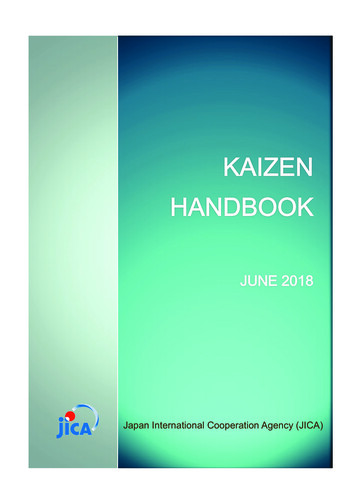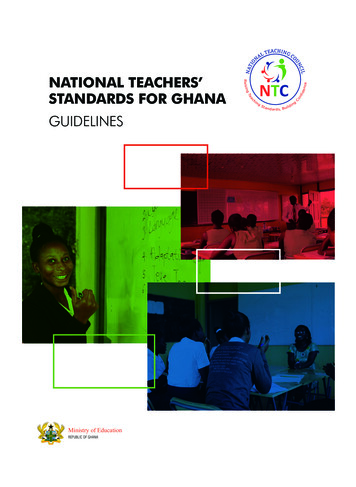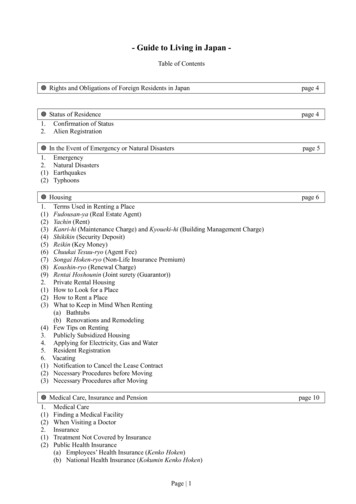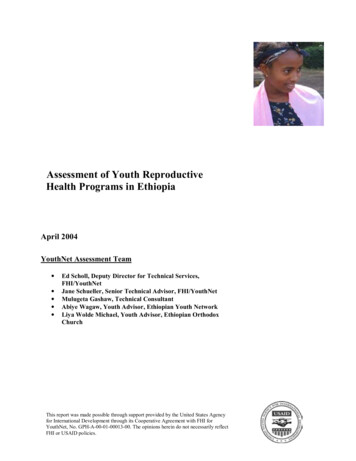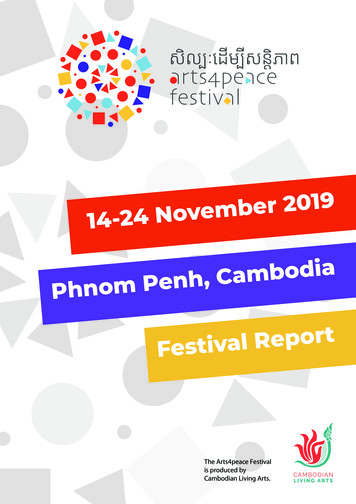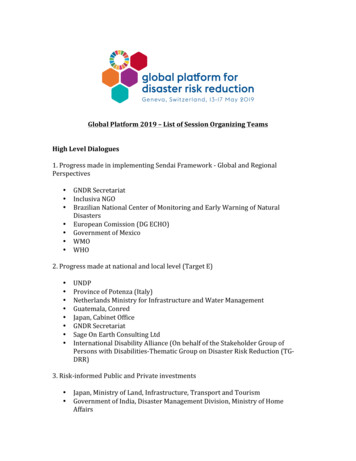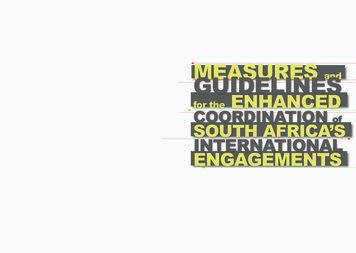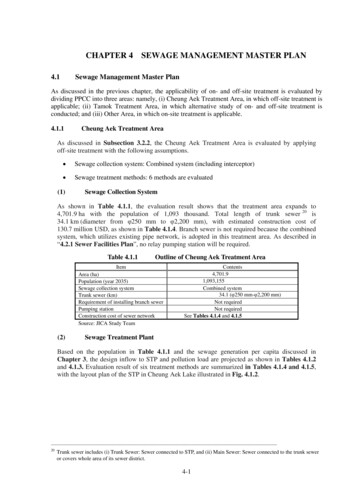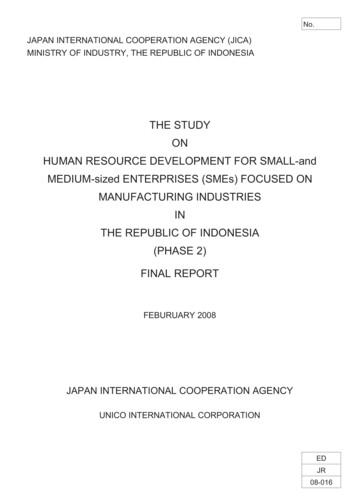
Transcription
No.JAPAN INTERNATIONAL COOPERATION AGENCY (JICA)MINISTRY OF INDUSTRY, THE REPUBLIC OF INDONESIATHE STUDYONHUMAN RESOURCE DEVELOPMENT FOR SMALL-andMEDIUM-sized ENTERPRISES (SMEs) FOCUSED ONMANUFACTURING INDUSTRIESINTHE REPUBLIC OF INDONESIA(PHASE 2)FINAL REPORTFEBURUARY 2008JAPAN INTERNATIONAL COOPERATION AGENCYUNICO INTERNATIONAL CORPORATIONEDJR08-016
PrefaceThe Government of Japan, in response to the request by the Government of Indonesia,decided to conduct a development study relating to the formulation of a human resourcedevelopment plan for SMEs in the country, and entrusted the undertaking of thedevelopment study to Japan International Cooperation Agency (JICA).JICA organized a study team led by Mr. Toru MORIGUCHI of UNICO InternationalCorporation and consisting of UNICO’s staff members, which visited Indonesia for fieldsurveys, totaling six times between September 2006 and January 2008.The study team held extensive discussions with personnel of Indonesian governmentministries and organizations, in addition to field surveys. It compiled this report as aresult of documentation and other works conducted in Japan after the field surveys.I sincerely hope that this report will contribute to promotion of SME-centric humanresource development policy in Indonesia, and then to the furtherance of friendlyrelationships between the two countries.Finally, I would like to express my deep appreciation to those who have providedcooperation and support for the study and its smooth implementation.February 2008Seiichi NagatsukaVice PresidentJapan International Cooperation Agency
February 2008Mr. Seiichi Nagatsuka,Vice PresidentJapan International Cooperation AgencyDear Mr. Nagatsuka,Letter of TransmittalWe would like to respectfully submit this report upon completion of “The Study onHuman Resource Development for Small-and Medium-sized Enterprises (SMEs) Focusedon Manufacturing Industries in the Republic of Indonesia (Phase 2)”.This study is the ramification of the technical cooperation project “The Study onHuman Resource Development for Small-and Medium-sized Enterprises (SMEs) Focusedon Manufacturing Industries in the Republic of Indonesia (Phase 1)” as well as ongoingrelevant project for SME consultant (Shindan-shi). These projects have providedopportunity for the Ministry of Industry (MOI) to renew its awareness of importance ofdirect consulting for SMEs, leading to the startup of a SME diagnosis consultant trainingcourse in 2006. Based on the results of these technical cooperation projects and against abackdrop of decentralization in progress, the present study was carried out to develop a setof proposals for institutional and organizational buildups as well as programs forimplementation of effective human resource development policy for SMEs by provincialgovernments.The study was commenced with field surveys covering various industrial humanresource development programs conducted by public and private organizations in East andWest Java, together with interview surveys of SMEs that belong to supporting industries.Then, the study team conducted model programs featuring diagnosis and advisory servicesof SMEs, jointly with Shindan-shi of East and West Java who had completed the SMEdiagnosis consultant training course.In the course of these surveys to examine the current state of the ongoing industrialhuman resource programs, the study team came to know the MOI’s new initiative toestablish a special unit to provide direct consulting service by local government, called
UPL-IKM. In parallel to the implementation of the model programs, the study teaminterviewed stakeholders relating to UPL-IKM and its activities and reviewed relevantreports and other documents. As a result, the study team concluded that the UPL-IKMinitiative had an adequate objective and implementation scheme, while its implementationplan seemed to satisfy the needs of local SMEs. The study team has developed andproposed, therefore, action plans that focus on the enhancement of UPL-IKM and thecontinuation of its activities by capitalizing on the results of the current state surveys andlessons learned from the model programs.We hope that UPL-IKM’s organization and activity will be widely adopted andproduce favorable results, thereby developing as core of industrial human resourcedevelopment activity on a local level.Finally, I would like to express my gratitude, on behalf of the study team, for broadsupport extended by Japan International Cooperation Agency, the Ministry of ForeignAffairs, the Ministry of Economy, Trade and Industry, and Japanese Embassy in Indonesiain the course of the present study. Also, I deeply thank personnel of the Indonesiancounterpart and other relevant organizations, in particular the MOI, Industry andCommerce DINASs in East and West Java, and human resource developmentorganizations in the public and private sectors, for extensive cooperation given to the studyteam.Very truly yours,UNICO International CorporationToru MoriguchiTeam Leader, the Study on Human ResourceDevelopment for Small-and Medium-sizedEnterprises (SMEs) Focused on ManufacturingIndustries in the Republic of Indonesia (Phase 2)
Map of Indonesia
AbbreviationsAIMCAssociation of Indonesian Management ConsultantsAMDIAstra Management Development InstituteAPBDAnggaran Pendapatan dan Belanja Daerah (Regional income and expenditure)APBNAnggaran Pendapatan dan Belanja Negara (National income and expenditure)APPAkademi Pimpinan Perusahaan (Leader academy of company)ASPEPAssosiasi Permesinan dan Pengerjaan Logam (Association of Metal Industry)ASPILOWAssosiasi Pengusaha Industri Logam Waru (Association of Metal Industry in Waru)BALAI BESARNational Research CenterBANK JATIMBank Jawa Timur (East Java Bank)BAPPENASBARISTANDBadan Perencanaan dan Pembangunan Nasional (National Development andPlanning Agency)Balai Riset dan Standarisasi (Research and standardization institution)BDIBalai Diklat Industri (Industrial Training Institute)BDSBisnis Development Service (Business Development Service)BDS-PBisnis Development Service Provider (Business Development Service Provider)BNSPBadan Nasional Sertifikasi dan Profesi (National profession certification agency)BPPIBPR JATIMBalai Penelitian dan Pengembangan Industri (Agency for Research andDevelopment of Industry and Trade of MOI)Bank Perkreditan Rakyat Jawa Timur (Public bank in East Jawa Province)BPTIBalai Pelayanan Teknis Industri (Industrial technique service center)BUMNBadan Usaha Milik Negara (National Enterprises)CADComputer Aided DesignCAMComputer Aided ManufacturingCEFECreation of Enterprises Formation of EntrepreneursDAKA PIMDakabalarea Pembinaan Industri Manufaktur (Manufacturing Development)DANA BERGULIRName of revolving fundDINASIndustry and Trade Office of Provincial GovernmentDIPDepartment of Industrial Promotion (Department of Industrial Promotion)EIEnterprises ImprovementEPAEconomic Partnership AgreementGDPGross Domestic ProductGRDPGross Regional Domestic ProductGTZGerman Technical Cooperation/ Deutsche Gesellschaft fur TechnischeZusammenarbeitIDKMIETCIndustri Dagang Kecil Menengah (Director General of Small and Medium Industryand Trade of MOI)Indonesian Export Training CenterIKMIndustri Kecil Menengah (General Office of SME)IMFInternational Monetary Fund-i-
ISOInternational Standard OrganizationITBInstitut Teknologi Bandung (Bandung Technology University)ITSInstitut Teknologi Surabaya (Surabaya Technology University)IVC-SIndustry Value Chain StrengthJABODETABEKJakarta, Bogor, Depok, Tanggerang, BekasiJICAJapan International Cooperation AgencyJITJust in TimeKADINKamar Dagang Indonesia (Indonesian Chamber of commerce and industry)KIKKredit Industri Kecil (Small Industry Loan)LDPLembaga Diklat Profesi (Professional training organization)LPBLembaga Pengembangan Bisnis (Business development body)LPB WARULembaga Pengembangan Bisnis Waru (Waru business development body)LPPMLSPLembaga Pendidikan dan Pembinaan Manajemen (Management of businessadministration institution)Lembaga Pengembangan Sumber Daya Manusia (Human Development Instituteunder YPMG)Lembaga Pembinaan Terpadu Industri dan Dagang Kecil (Development institute ofsmall industry and trade)Lembaga Sertifikasi Profesi (Profession certification body)MINISTRY OF BUMNKementrian Badan Usaha Milik Negara (Ministry of National Company)MOIMinistry of IndustryMONEMinistry of National EducationMTAPMedium Term Action PlanNPONon Profit OrganizationOEMOriginal Equipment ManufacturingPFPPPOLBANPejabat Fungsional Penyuluh Perindustrian dan Perdagangan (Extension officer ofindustry and trade)Politeknik Negeri Bandung (Politechnic in Bandung)POLMANPoliteknik Manufaktur Negeri Bandung (Politechnic in Manufacturing)PPMPusat Pengembangan Manajemen (Center for Management Development)PRASETYABusiness School Name (Name of Business School)PROPENASProgram Pembangunan Nasional (National Development Program)PUSDIKLATPusat Pendidikan dan Latihan Industri (Center for Education and Training)PUSDIKLAT-INDQSPusat Pendidikan dan Latihan Industri (Center for Education and Training ofIndustry and Trade)Quality SystemR/DResearch DevelopmentRENSTRARencana Strategis (Strategic Planning)SENTRACenterSIAPThe Strategic Investment Action PlanSKKNIStandart Kompetensi Kerja Nasional Indonesia (National standard for professioncompetency)LPSMLPT-INDAK- ii -
SMESmall Medium EnterpriseSNIStandart Nasional Indonesia (Indonesian Standard)STMISekolah Teknik Menengah Industri (Industrial Technical School of middle level)TORTerm of ReferenceTSTechnical SpecificationUKMUsaha Kecil Menengah (Small and Medium Enterprises)UPLUnit Pelayanan Langsung (Direct Service Unit)UPTUnit Pelayanan Teknis (Common Service Facilities)YBMBYayasan Bina Mitra Bakrie (BINA MITRA BAKRIE Foundation)YDBAYayasan Dana Bhakti Astra (DHARMA BHAKTI ASTRA Foundation)YPMGYayasan Pendidikan Matsushita Gobel (MATSUSHITA GOBEL EducationFoundation)- iii -
- iv -
Table of ContentsChapter 11.1Overview of the Study .1-1Background of the Study.1-11.1.1Indonesia after the Asian Financial Crisis .1-11.1.2Japan’s Assistance in SME Human Resource Development inIndonesia.1-21.1.3Positioning of the Study.1-41.2Objective of the Study.1-61.3Target Sector and Enterprises of the Study.1-71.4Scope of the Study .1-81.5Study Framework .1-81.6Work Description of Study Team Members .1-91.7Field Work Schedule.1-111.8Workshops.1-12Chapter 2National Development Plan and SMEs Promotion Policy inIndonesia .2-12.1The National Development Plan and Its Positioning .2-12.2100-day Development Plan .2-12.2.1Industry groups covered by MOI’s 100-day development plan .2-22.2.2Outcomes expected from MOI’s 100-day development plan.2-22.2.3SME Promotion in MOI’s 100-day development plan.2-22.3Medium-term and Long-term National Development Plans.2-32.3.1Medium-term national development plan (2004 – 2009) .2-32.3.2Long-term national development plan (2005 – 2025) .2-52.4SMEs Development Strategy .2-72.4.1Issues to tackle for industrial development under RENSTRA .2-72.4.2Two pillars of RENSTRA .2-72.4.3Goals for industrial development.2-92.4.4Development concept in RENSTRA for the nurturing ofmanufacturing sector in general and relevant sectors in the Study .2-102.5SME Promotion Policies and New Economic Policy Package.2-15-v-
Chapter 33.1Decentralization and SME Promotion .3-1Decentralization and SME Promotion .3-13.1.1Decentralization and SME promotion policy .3-13.1.2Evolution of government organization relating to SME promotionpolicy implementation as a result of decentralization .3-43.1.33.2Public SME loan program .3-7SME Promotion Policy by East Java Government .3-73.2.1Renstra in East Java .3-73.2.2Industry and Trade DINAS in East Java.3-83.2.3Public SME loan programs in East Java.3-153.3SME Promotion Policy by West Java Government .3-213.3.1RENSTRA in West Java.3-213.3.2Industry and Trade DINAS in West Java .3-243.3.3Public SME loan program in West Java .3-29Chapter 44.1Human Resource Development for SMEs and Supporting Program.4-1Human Resource Development for SMEs of the Ministry of Industry(MOI) .4-14.1.1PUSDIKLAT-IND.4-34.1.2Directorate General of Small-Medium Scale Industries (IKM) .4-54.1.3Agency for Research and Development of Industry and Trade (BPPI) .4-74.2SME Consulting System and UPL-IKM.4-74.2.1SME Consulting System.4-74.2.2UPL-IKM.4-124.3Human Resource Development by Private Sector .4-204.3.1Non-profit organizations.4-214.3.2Management institutions.4-224.3.3POLMAN (Manufacturing orient polytechnic) .4-234.4Major organizations relating to the fostering of supporting industries inEast Java.4-234.4.1Industry and Trade DINAS in East Java.4-244.4.2BPTI Logam (BALAI PELAYANAN TEKNIS INDUSTRILOGAM) .4-26- vi -
4.4.3BDI (Balai Diklat Industri).4-274.4.4BARISTAND (Balai Rieset dan Standarisasi) .4-284.4.5LPB Waru (LEMBAGA PENGEMBANGAN BISNIS WARU) .4-284.4.6ITS – AIMC’s Surabaya Chapter .4-294.4.7KADIN (Kamar Dagang Indonesia).4-294.4.8East Java SME & Cooperative DINAS .4-294.4.9East Java Labor Department DINAS.4-304.5Major Organizations Relating to the Fostering of Supporting Industries inWest Java .4-314.5.1Industry and Trade DINAS in West Java .4-324.5.2Balai Besar.4-344.5.3Politeknik.4-354.5.4State enterprises .4-364.6Current State of SME Promotion by Other Donor Organizations .4-374.6.1US AID’s SENDA Project.4-374.6.2US AID’s SENADA Project in local areas.4-39Chapter 55.1Supporting Industries in Indonesia.5-1General Outline and Major Issues of Supporting Industries in Indonesia .5-15.1.1General outline of supporting industries in Indonesia.5-15.1.2Major issues of supporting industries in Indonesia .5-55.1.3Organizations responsible for fostering of supporting industries inIndonesia.5-65.1.4Technical support projects and programs relating to development ofsupporting industries.5-75.2General Outline and Major Issues of Supporting Industries in Local Areas .5-95.2.1Current state of supporting industries in East Java.5-95.2.2Current state of supporting industries in West Java .5-155.2.3Visiting survey results of the current state of SMEs .5-21Chapter 66.1Model Programs .6-1Implementation Plan for the Model Programs .6-16.1.1Objective of the Model Programs.6-1- vii -
6.1.26.2Relationship with the SME Consulting System.6-1Model Program Scheme .6-36.2.1Model Program A .6-36.2.2Model Program B .6-76.3Activities and Results of Model Program A .6-86.3.1East Java .6-106.3.2West Java .6-236.4Results of Model Program B.6-336.4.1East Java .6-346.4.2West Java .6-36Chapter 77.1Evaluation of Model Programs .7-1Model Program A.7-17.1.1Questionnaire survey of model companies.7-17.1.2Findings of study team experts .7-137.1.3Verification of program results.7-267.2Model Program B .7-307.2.1Demand for special consultants and specialty fields .7-317.2.2Intent of participation in UPL-IKM’s activities by outside supportorganizations, educational institutions, and private consultants.7-31Chapter 8Questionnaire Survey of Shindan-shi of the SME DiagnosisConsultant Training Course in 2006 .8-18.1Objective of the Questionnaire Survey .8-18.2Survey Method and Responses .8-18.3Results of the Questionnaire Survey .8-28.3.1Key attributes of respondents .8-28.3.2Status of establishment of UPL-IKM .8-98.3.3Activity status of Shindan-shi of the 2006 SME DiagnosisConsultant Training Course.8-118.3.4Future activities of Shindan-shi .8-288.3.5SME Diagnosis Consultant Training Course.8-328.4Analysis of Questionnaire Survey Results.8-34- viii -
8.4.1UPL-IKM.8-348.4.2Shindan-shi of the 2006 SME Diagnosis Consultant Training Course .8-368.4.3SME Diagnosis Consultant Training Course and retraining .8-39Chapter 9Current Status of Human Resource Development for Local SMEs ofthe Manufacturing Sector.9-19.1Human Resource Development for Local SMEs of the ManufacturingSector.9-19.1.1Manufacturing SMEs.9-19.1.2Human resource development for SMEs of the manufacturingindustry .9-29.1.3Role of government in industrial human resource development .9-59.1.4Roles of central and local governments in industrial human resourcedevelopment.9-79.1.5Survey of human resource development demand in themanufacturing industry (Phase I Study) .9-119.2Current State of Human Resource Development for Local SMEs of theManufacturing industry.9-149.2.1Human resource development programs for manufacturing SMEs byministries.9-149.2.2New approach by IKM of MOI .9-169.2.3Current state of human resource development initiatives for SMEs ofthe manufacturing industry by Provincial Industry and Trade DINAS.9-20Chapter 10 Recommendation of Action Plans for Human Resource Developmentfor SMEs of the Manufacturing Industry by Provincial Industry andTrade DINAS .10-110.1 Issues Relating to Human Resource Development for SMEs of theManufacturing Industry Identified in the Present Study .10-110.1.1Issues relating to SMEs in the Indonesian manufacturing industry .10-110.1.2Issues relating to the MOI’s implementation system for industrialhuman resource development support .10-4- ix -
10.1.3Issues relating to the provincial government’s implementationsystem for human resource development programs for themanufacturing sector .10-710.1.4Issues relating to Shindan-shi .10-910.2 Future Vision of Human Resource Development Promotion for theManufacturing Industry through Collaborative Efforts of the CentralGovernment (MOI) and Provincial Governments.10-1110.3 Proposal for Human Resource Development Support for theManufacturing Industry by Provincial Industry and Trade DINAS.10-1410.3.1Action Plan 1: Organization and membership of UPL-IKM.10-1410.3.2Action Plan 2: Establishment of provincial UPL-IKM committee .10-1610.3.3Action Plan 3: Development of a database on SME specialconsultants .10-1910.3.4Action Plan 4: Linking UPL-IKM’s diagnosis and advisory servicewith loan schemes.10-2110.3.5Action Plan 5: Retraining program for Shindan-shi .10-2310.3.6Action Plan 6: Organization of periodical workshops and events forcompanies .10-2510.3.7Implementation Schedule for the Action Plans .10-2610.4 Proposals Relating to the SME Diagnosis Consultant Training Course .10-2810.4.1Sectors covered by diagnosis and advisory service.10-2810.4.2Selection criteria for course participants .10-2910.4.3Implementation of TOT.10-29AppendixAppendix -1Report on Corporate Diagnosis and Advisory Activities under ModelProgramAppendix -2Interview Survey Questionnaire Companies Participating in the ModelProgramAppendix -3Questionnaire Graduates of the First SME Consultant Training CourseAppendix -4Number of Companies that have received diagnosis / consulting serviceby sector and employment size (each province)Appendix -5Sectors intended for future diagnosis activities by employment size(each province)-x-
List of TablesChapter 1Overview of the Study(page)Table1-1Formation and Business for Which One is Responsible of Study Team1-91-2Field Study Schedule and Activities1-111-3Workshops during the Survey Period1-12Chapter 2National Development plan and SMEs Promotion Policy in IndonesiaTable2-1Chapter 3Decentralization and SME PromotionTable3-1Fiscal Budget of Industry and Trade DINAS in East Java3-123-2Numbers of KIK Loan Applications and Loans3-163-3Total Amount of KIK Loans3-163-4UKM Loans in the First Half of 20073-173-5Public SME Loans in FY20063-30Numerical Goals in the Mid-Term Development Strategy2-4Chapter 4Human Resource Development for SMEs and Supporting ProgramTable4-1Training Program of IKM in 20074-64-2Subject List of the SME Diagnosis Consultant Training Course4-104-3Member Structure of UPL-IKM in East Java Province4-254-4Specialist Groups in Industry and Trade DINAS of East Java Province4-264-5Member List of UPL in West Java Province4-334-6Action Plan of UPL-IKMs in West Java Province in 20074-344-7Target Sectors of US AID and its Activity Areas4-38Chapter 5Supporting Industries in IndonesiaTable5-1Percentage Contribution by Key Industry Sectors to GRP in East Java5-105-2Growth Rate by Industrial Sectors in East Java Province5-115-3Data on Manufacturing Enterprises in East Java by Sizes5-125-4Numbers of Enterprises and Employees by Industrial Clusters5-145-5Percentage Contribution by Industry Sectors to GDRP in West Java Province5-165-6Numbers of Employees by Sizes of Enterprises in West Java Province (2005)5-175-7Breakdown of Percentage Contribution to GRDP in Manufacturing Industry by5-17Company Sizes (2005)5-8Growth Rate of GRDP by Industry in West Java Province5-185-9Distribution of Enterprises by Sizes in Each Industry (2005)5-185-10Numbers of Companies Visited by Sectors5-225-11Average Number of Employees in Each Sector5-22- xi -
Table5-12Sales per Employees5-235-13Technical Speciality5-245-14Ratio of OEM5-245-15Urgent Issues Raised in East Java5-255-16Urgent Issues Raised in West Java5-255-17Desirable Areas of Employee Education and Training5-265-18Answers to Whether to Wish to Receive Technical Guidance from5-27Outside Experts, East Java5-19Answers to Whether to Wish to Receive Technical Guidance from5-27Outside Experts, West Java5-205-Grade Rating Criteria for Sub-Items5-285-21Evaluation Results, East Java5-285-22Evaluation Results, West Java5-28Chapter 6Model ProgramsTable6-1List of Key Kaizen Issues Selected f
support extended by Japan International Cooperation Agency, the Ministry of Foreign Affairs, the Ministry of Economy, Trade and Industry, and Japanese Embassy in Indonesia in the course of the present study. Also, I deeply thank personnel of the Indonesian counterpart and other relevant organizations, in particular the MOI, Industry and


